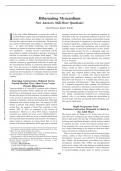See related article, pages 970 –977
Hibernating Myocardium
New Answers, Still More Questions!
Gerd Heusch, Rainer Schulz
I
n the early 1980s, Rahimtoola1 reviewed the results of coronary constrictor there was no significant reduction in
coronary bypass surgery trials and identified patients with blood flow at the time of maximum reduction of systolic wall
coronary artery disease and chronic left ventricular dys- thickening.7 Collectively, these authors dismissed the concept
function that improved upon revascularization. He proposed of chronic hibernation as adaptation to a persistent reduction
the concept of hibernating myocardium as “prolonged ische- in baseline blood flow, emphasized the idea of cumulative
mia. . . in which myocardial metabolism and ventricular stunning as the underlying mechanism and criticized the
function are reduced to match the reduced blood supply. . ., a available studies on short-term hibernation for their insuffi-
new equilibrium. . . whereby necrosis is prevented, and the cient observation period.8 In fact, a subsequent study con-
myocardium is capable of returning to normal or near-normal firmed that in a pig model of subacute ischemia, perfusion/
function on restoration of an adequate blood supply.”1 This contraction matching and viability were maintained for 90
clinically based concept quickly found its experimental coun- minutes but progressively lost when ischemia was extended
terpart in a number of studies that characterized acute and to 12 or 24 hours.9
subacute ischemia by proportionate reductions in blood sup- Canty and Fallovollita reconciled these, at the time, heated
ply and contractile function, ie, perfusion-contraction match- controversies on reduced versus normal baseline blood flow.
ing.2 Also, the recovery of initially disturbed substrate and Using a model in which a fixed stenosis is implanted in
energy metabolism during ongoing ischemia supported the juvenile pigs and becomes progressively flow-limiting when
notion that downregulation of contractile function permitted they grow, they reported normal resting blood flow but
the myocardium to recover its metabolism and sustain its reduced function 1 to 2 months after stenosis placement,
viability.3 consistent with cumulative stunning,10 and both decreased
blood flow and function 3 to 4 months after stenosis place-
Emerging Controversies: Reduced Versus
Downloaded from http://ahajournals.org by on June 12, 2020
ment, consistent with hibernation.11 Thus, there appeared to
Normal Baseline Flow; Short-Term Versus be a temporal progression from stunning with perfusion/
Chronic Hibernation contraction mismatch to hibernation with perfusion/contrac-
Vanoverschelde et al4 using PET in patients with collateral- tion match. A limitation of these elegant studies was, how-
dependent myocardium found a significant 19% reduction in ever, that although episodes of stunning were observed they
blood flow in dysfunctional versus remote reference regions; were neither systematically monitored nor systematically
because this degree of flow reduction was modest in relation
induced. Also, it was unclear whether the observations in
to the severity of dysfunction, they reasoned that this was a
juvenile hearts with their presumably greater plasticity were
situation of cumulative stunning with normal flow rather than
also true for adult hearts.
hibernation with reduced resting flow. The majority of PET
studies in patients with chronic hibernation report reduced
resting flow; the amount of blood flow reduction is only Rapid Progression From
modest (20% to 30%) as compared to the severity of Perfusion-Contraction Mismatch to Match in
dysfunction.5 However, in these PET studies, transmural the Adult Heart
resolution was lacking and more severe subendocardial is- The present study by Thomas et al12 in this issue of Circu-
chemia could not be ruled out, and it is subendocardial blood lation Research corroborates the earlier findings and extends
flow that determines transmural wall function.6 Nevertheless, them to adult hearts. The fact that 15-minute partial coronary
others found no reduction in resting blood flow at all in occlusion and reperfusion through a critical stenosis resulted
patients with chronic hibernation, and in pigs with an ameroid in matched decreases in flow and function already after 1
week minimizes the vocal concerns that lack of chronicity
The opinions expressed in this editorial are not necessarily those of the was a major shortcoming of the studies on short-term hiber-
editors or of the American Heart Association. nation and points to mechanistic differences.
From the Institute of Pathophysiology, Centre of Internal Medicine, There were also signs of myolysis and increased glycogen
University of Essen Medical School, Essen, Germany.
Correspondence to Prof Dr med Dr hc Gerd Heusch, Director, Institute content, similar to those observed in human hibernating
of Pathophysiology, Centre of Internal Medicine, University of Essen myocardium,13 however, not restricted to the dysfunctional
Medical School, Hufelandstr 55, 45122 Essen, Germany. E-mail area. Finally, the dysfunctional myocardium had reduced
gerd.heusch@uni-essen.de
(Circ Res. 2002;91:863-865.)
sarcoplasmic reticulum (SR) ATPase and phospholamban
© 2002 American Heart Association, Inc. protein levels. Along with earlier findings of reduced calcium
Circulation Research is available at http://www.circresaha.org responsiveness in short-term hibernation9, 14 these alterations
DOI: 10.1161/01.RES.0000043397.97121.D5 in calcium-handling proteins point to altered excitation-
863




